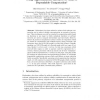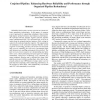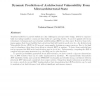113 search results - page 16 / 23 » Architectural-Level Fault Tolerant Computation in Nanoelectr... |
RANDOM
1998
Springer
13 years 11 months ago
1998
Springer
Abstract. Redundancy has been utilized to achieve fault tolerant computation and to achieve reliable communication in networks of processors. These techniques can only be extended ...
MICRO
2010
IEEE
13 years 5 months ago
2010
IEEE
Single-thread performance, reliability and power efficiency are critical design challenges of future multicore systems. Although point solutions have been proposed to address thes...
EDOC
2007
IEEE
14 years 1 months ago
2007
IEEE
Dependable software systems are difficult to develop because developers must understand and address several interdependent and pervasive dependability concerns. Features that addr...
PRDC
2008
IEEE
14 years 1 months ago
2008
IEEE
Reliability has become a serious concern as systems embrace nanometer technologies. In this paper, we propose a novel approach for organizing redundancy that provides high degree ...
ISCA
2007
IEEE
14 years 1 months ago
2007
IEEE
Transient faults due to particle strikes are a key challenge in microprocessor design. Driven by exponentially increasing transistor counts, per-chip faults are a growing burden. ...



